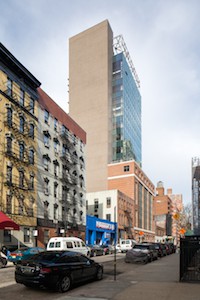Trevor Day School, located in New York City, is using geothermal for energy and education. The technology used is the first by an educational institute as well as the first on the East Coast to contribute to New York City Mayor Bill de Blasio’s goal to reduce greenhouse gas emissions (GHGs) by 80 percent prior to 2050.
The system contains structural piles that are made from reinforced concrete. They are turned into heat exchangers by adding loops of plastic pipes down their length with some going more than 80 feet deep. They provide both support for the building, but also allow the structure to extract and store heat from the earth to use in heating and cooling the building.

A view from First Avenue of Trevor’s new LEED qualifying, state-of-the-art, geothermal school building; a first of its kind on the East Coast. (Photo: Business Wire)
To learn more about the project, DomesticFuel spoke to several of the project team members including Michael Paquette, P.E. senior project engineer for Langan. He explained that this technology was different than many current geothermal projects.
On ‘traditional’ geothermal projects, the geothermal loops are installed in boreholes drilled specifically to install the geothermal loops, or in shallow trenches excavated specifically for geothermal loops, explained Paquette. However, at Trevor Day School, the geothermal loops were installed in pile foundations that were already required for the building (hence the term ‘energy piles’).
“The value of the energy piles is that the piles must be installed for the building’s foundation support, so adding geothermal loops inside the piles themselves is a relatively lower cost compared to drilling dedicated boreholes for the geothermal loops,” continued Paquette. “The piles serve dual purpose as foundation support and energy transfer. Although energy piles are becoming more common in Europe, Trevor Day School is one of the first projects in the USA to use this technology and will hopefully serve as a catalyst for other developers in the U.S. to consider this technology.”
What is the return on investment of this clean energy technology?
Prior to engaging in the project, Viridian Energy & Environmental analyzed the energy use of the design for the 102,000 square foot building. Viridian used computer software to model the building design and evaluate energy efficiency measures. The software, DOE-2.1E, calculates the hour-by-hour energy use of a building based on information on the building’s location, construction, HVAC systems, central plant, occupancy, and operation.
As explained by Virdian, these results are not predictions of actual energy use, which based on experience, can be 40 percent higher than energy use predicted by this type of modeling. The model assumes perfection in the thermal properties of the materials, in the energy efficiency characteristics of equipment, in the installation of in operation. Thus, it was recommended to take the energy use figures for the design and multiply by 1.3 or 1.4 to get the rough estimate of what actual energy use and cost savings might be. The annual energy savings are predicted to range between $55,699 (1.3 multiplier) and $59,983 (1.4 multiplier). Trevor’s investment in this system was $333,000.
Reisinger, said the school hopes to re-invest the energy cost savings. For example, the school will be expanding and enhancing their STEAM offerings year after year. (The objectives of the STEAM movement are to transform research policy to place Art + Design at the center of STEM.) “It is a top priority of the school. It is too early, however, to direct predicted cost savings to these specific curricular enhancements. We will need to exist within the new building for several years, adjusting systems as needed, and confirming savings, before we can think about how we reinvest the savings,” said Reisinger.

Geothermal Energy system installed at Trevor Day School in New York City. The clean energy technology is providing both energy savings and STEAM education for students. Photo Credit: Trevor Day School
As schools across the country look to become more energy efficient and sustainable, geothermal energy is an energy source that should be considered. Paquette said that geothermal can be a good choice for alternative energy if the building design and ground conditions are appropriate.
“An evaluation of both the energy demand, typically from the MEP engineer and architect, and the ground conditions, typically a geotechnical engineer or geologist, early in the design is critical,” noted Paquette. “During concept planning the feasibility of using geothermal energy can be vetted and the different methods of tapping geothermal energy can be compared. For a building that requires piles for foundation support, such as at Trevor Day School, using those already relatively expensive piles to capture relatively cheap energy can be an easy decision.”
McClintock adds that having an environmentally sustainable building is crucial to teaching students about sustainability issues. “In the past, students have perceived a gap between what we say and what we do, and that makes issues of sustainability seem less important than they are. By using our own school as a subject of experimentation, being good stewards of the environment becomes an issue of immediate and personal relevance.”

